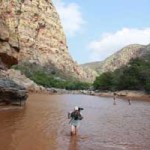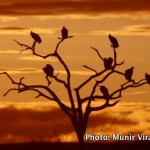African Fish Eagles at Lake Naivasha: Using an apex predator to determine the effect of human activity on a lake ecosystem. Shiv Kapila

The African Fish Eagles at Lake Naivasha have been studied for over 40 years, firstly by the late Leslie Brown, and more recently, by raptor biologists from The Peregrine Fund, Cambridge University, The University of Leicester and The Earthwatch Programme. I first joined this research programme for my Masters Degree dissertation six months ago and now, with support from The Peregrine Fund and the National Museums of Kenya, I am aiming to build on current data.
The main objective of this study is to track fish eagle populations and breeding rates at Lake Naivasha and relate them to a number of environmental factors such as water levels and waterfowl numbers, and also to anthropogenic effects such as habitat loss. The eagles are a notable and obvious resident of the lake’s surrounding woodland and draw thousands of visitors to the area every year.
Since the early 70s the lake has faced pressures stemming from a growing horticultural industry, which has sprung up around its shores. The huge demand for water to supply these farms is abstracted directly from the lake. In addition, the Acacia dominated riparian woodland has been cleared in large tracts while the quality of the papyrus fringe has been degraded much to the detriment of the lake. Before the advent of these farms, the lake supported over 200 fish eagles with a high proportion of juveniles. Over the years the fish eagle population has fluctuated widely with 67 individuals recorded in the mid 90s. During my study over the last six months, the maximum number of eagles that I have recorded around the lake has been 110, with less than 10% being juveniles or sub-adults.
A breeding survey of fish eagles around the lake is in progress. Early results show that only pairs in good habitat (full, closed tree canopy, steep shores resilient to water level fluctuations) have attempted to breed in the last six months, but pairs in marginal habitat (shallow gradient shores, few trees, close to areas of human disturbance) show absolutely no inclination to do so. This discrepancy is mostly due to an ongoing drought in the area (although flower farms’ water abstraction rates greatly exacerbate this problem)-water levels are at a 60 year low and the distances of the shore to the treelines in marginal habitat are huge; a 3 metre drop in levels has resulted in this distance to be up to 3 kilometres in some places, making it much harder for eagles to catch their prey. In times like these when productivity is low, these birds catch barely enough food to survive, let alone reproduce.

To show the difference in conditions between eagles in different habitats, I am also studying their behaviour. By observing eagles and recording hunting success and soaring time (used to advertise their presence to adjacent pairs, something which eagles in poorer habitats may spent more time doing to defend their larger territories) we can hopefully determine the stress that different pairs are under. L. H. Brown logged over 1,000 hours of eagle observation when the lake was in a pristine state in the late 60s and early 70s. Results from this study can be compared to data gathered by Brown to give indications of how different conditions affect the eagles’ daily routine.
Over the last 12 years at Lake Naivasha about 60 fish eagles have been ringed in order to get re-sight data and to determine a mortality rate. With such a study we can derive a model to predict if populations are expanding, stable or declining. Of these 60 birds about 15 have been confirmed as dead, either by territorial fights, electrocution by power lines or from unknown causes. This is a reasonably high rate of decline, but these eagles tend to be replaced rather quickly and more research needs to be carried out. I survey the lake’s eagles every four months or so and my aim is to publish this data in the recent future.
Aknowledgements:
This work has been kindly supported by The Peregrine Fund, and the National Museums of Kenya, with technical support in the field by Dr. Munir Virani. The Elsamere Field Study centre has provided accommodation for all field operations at Lake Naivasha-a place I would recommend whole heartedly.




This is very nice work.
It will be good to link up with you since i have also been doing some work on woodlands of Naivasha with Prof. Harper.